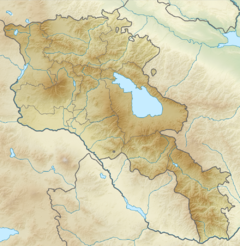 View of the research station's buildings and the surrounding lanscape View of the research station's buildings and the surrounding lanscape | |
| Location | Mount Aragats, Armenia |
|---|---|
| Coordinates | 40°28′17″N 44°10′55″E / 40.4713°N 44.1819°E / 40.4713; 44.1819 |
| Altitude | 3,200 metres (10,500 ft) |
| Established | 1943 (1943) |
 | |
| | |
| [edit on Wikidata] | |
The Aragats Cosmic Ray Research Station was founded in 1943 by Artem and Abraham Alikhanians (Abram Alikhanov), during World War II, to study cosmic ray and particle physics. It is located on Mount Aragats in Armenia, at an elevation of 3,200 meters, near Kari Lake.
History

Research on cosmic rays at Aragats started with a 1934 study by the Leningrad Physical-Technical Institute, focusing on how cosmic rays differ from East to West. Norair Kocharian from Yerevan State University later added to this research. These early findings led Artem and Abraham Alikhanians to set up a more detailed study in 1942. the station has been operational with minimal interruption since establishment.
Since it was set up, the Aragats station has made contributions to studying cosmic rays including the fields of High-Energy Particle Physics, Astrophysics, and Space Weather.
In its early stages, the station used mass spectrometry to study the properties of charged particles, contributed by the Alikhanyan brothers. This work, which took about 15 years, helped improve methods for analyzing masses and identifying cosmic ray protons. The idea of 'varitrons,' proposed during this time, aroused discussions in the science community about elementary particles, even though not all findings were confirmed. This discussion helped establish Aragats as a location for cosmic ray research
The period from 1958 to 1970
From 1958 to 1970, progress was made in cosmic ray research through calorimetric methods. Naum Grigorov and his team, working with the Yerevan Physics Institute, installed an ionization calorimeter, leading to research into hadron-nuclei interactions. Following experiments like PION and MUON used advanced detectors and early computers for data gathering and analysis.
1980s
In the 1980s, the ANI experiment was planned to analyze Extensive Air Showers (EASs) using large detectors to study a wide range of cosmic ray types and energies. However, the dissolution of the USSR posed challenges to its full execution. Despite such, the MAKET-ANI and GAMMA projects published in high-energy cosmic ray research
Aragats Space Environmental Center (ASEC)

In 2000, the Aragats Space Environmental Center (ASEC) was established, aimed to enhance research in solar physics and space weather. ASEC employs neutron monitors and scintillation detectors to track cosmic ray fluxes and create early warning systems for solar energetic particle events. With the launch of the SEVAN detector network in 2007, the station improved its detection ability on particle acceleration and movement in the solar corona and interplanetary space.
The network's initial setups were in Croatia, Bulgaria, and India. Expansion continued with the installation of SEVAN detectors in Croatia, Slovakia, Germany (Hamburg and Berlin), Czech Republic, and atop Zugspitze in 2023.
References
- Logachev, Yu I.; Lazutin, L. L.; Kudela, K. (2013-02-13). "Cosmic Ray Investigation in the Stratosphere and Space: Results from Instruments on Russian Satellites and Balloons". Advances in Astronomy. 2013: e461717. Bibcode:2013AdAst2013E...6L. doi:10.1155/2013/461717. ISSN 1687-7969.
- "'We're above civilisation': life in a cosmic ray station – photo essay". The Guardian. 2020-02-07. ISSN 0261-3077. Retrieved 2024-04-09.
- MassisPost (2023-01-03). "New Discoveries of Aragats Physicists • MassisPost". MassisPost. Retrieved 2024-04-09.
- "Alikhanian–Alikhanov spectrometer", Misplaced Pages, 2022-04-05, retrieved 2024-04-09
- Chilingarian, A. A.; Mirzoyan, R. G.; Zazyan, M. Z. (2009-09-01). "Cosmic Ray research in Armenia". Journal of Contemporary Physics (Armenian Academy of Sciences). 44 (5): 219–230. Bibcode:2009JConP..44..219C. doi:10.3103/S106833720905003X.
- Harvey, Brian; Zakutnyaya, Olga (2011-05-04). Russian Space Probes: Scientific Discoveries and Future Missions. Springer Science & Business Media. ISBN 978-1-4419-8150-9.
- Arzumanian, S. A.; Chilingarian, A. A.; Eganov, V. S.; Garyaka, A. P.; Ivanov, V. A.; Mamidjanian, E. A.; Martirosov, R. M.; Nikolskaya, N. M.; Nikolsky, S. I.; Procureur, J.; Romakhin, V. A.; Satin, A. K.; Stamenov, J. N.; Subbotin, B. V.; Tukish, E. I. (1995). "1995ICRC....1..482A Page A482". International Cosmic Ray Conference. 1: 482. Bibcode:1995ICRC....1..482A. Retrieved 2024-04-10.
- Chilingarian, A.; Gharagyozyan, G.; Hovsepyan, G.; Ghazaryan, S.; Melkumyan, L.; Vardanyan, A. (2004-03-01). "Light and Heavy Cosmic-Ray Mass Group Energy Spectra as Measured by the MAKET-ANI Detector". The Astrophysical Journal. 603 (1): L29 – L32. Bibcode:2004ApJ...603L..29C. doi:10.1086/383086. ISSN 0004-637X.
- "Aragats Space Environmental Center(ASEC) - Cosmic Ray Division". crd.yerphi.am. Retrieved 2024-04-10.
- "Space Environmental Viewing and Analysis Network - Cosmic Ray Division". www.crd.yerphi.am. Retrieved 2024-04-10.
- "/ AANL SCIENTISTS INSTALLED SEVAN DETECTOR ON ZUGSPITZE IN BAVARIAN ALPS ON 18 APRIL". www.aanl.am. Retrieved 2024-04-10.
External Links
- Official website
- A. Alikhanyan National Laboratory (YerPhI)
- https://www.theguardian.com/science/2020/feb/07/cosmic-ray-research-station-mount-aragats-photo-essay
- https://www.rferl.org/a/armenia-mountaintop-research-facility-that-was-once-weapons-development-lab/30391548.html
- https://www.thetimes.co.uk/article/inside-the-armenian-ghost-town-with-a-population-of-three-tzgn6nzn7
- http://www.crdfriends.org/